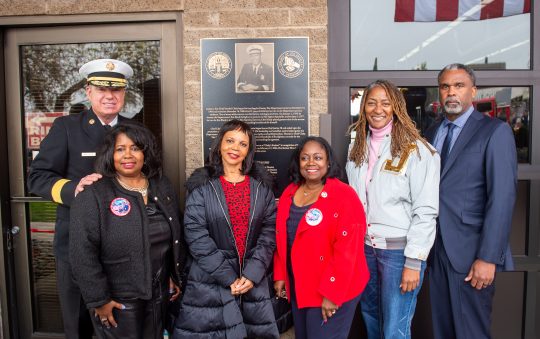
“We got what we wanted, but lost what we had,” (An Eastside boy)
Older Blacks often compare conditions under lawful segregation with post-civil rights de-facto segregation that legally afforded them greater opportunities but did not eliminate the barriers that still block such opportunities.
Nowhere is this dilemma more evident than in the conversations of Los Angeles’ Eastside Boys who grew up in the 1930s through the 1950s. Some were born in Los Angeles; others came with their families, mostly from the South, and found Los Angeles, in many ways, just as segregated as the cities and towns they came from. Paradoxically, segregation spawned strong individual and community bonds that significantly evaporated because the new opportunities steadily fueled a mass exodus from the Eastside.
(The Eastside was not East Los Angeles. Its boundaries were Main Street on the west, Alameda Street on the east, Washington Blvd on the north and Slauson Avenue on the south.) The Eastside Boys (now Eastside Boys and Girls) continue to meet every summer, a testament to their resilience and lasting affinity.
The balance of today’s column consists of excerpts from Erin Aubry-Kaplan’s (then Erin J. Aubry) 1997 Los Angeles Times Magazine cover story, “The Eastside Boys.”
Most Blacks left the Eastside when they could, as soon as they could, starting in the early ‘50s; it was an onward flow that, in retrospect, was a hemorrhage, an exodus of Black people from a place that both built them and bound them. It’s an old story to all of us now: the sudden fury of flight and the broken economy left in its wake, like debris scattered in the aftermath of a storm.
Still, out in the new territory of the Westside and South Bay, of Crenshaw and Ladera Heights and Baldwin Hills, a lot of promise was realized in the form of college educations and fruitful careers—more opportunities for the Eastside Boys and their children. The Eastside Boys respected and supported one another and felt there was nothing especially noble or self-sacrificing about it; but they find themselves where they never expected to be, in the role of heroes and gatekeepers, living connections to the last era of bountiful times for many Black people. They are the flashpoints of a social upheaval that cast off segregation and laid a new course.
None offered (when interviewed) any definitive answers. Yet, in spite of a city so changed from what they knew, so disparate and willfully disconnected, their spirit was never broken. My father said, “To me, it’s more a matter of (pause)……..It’s a good feeling, a link to the past. It was the sort of environment devoid of judgment; it didn’t matter who you were, judge or janitor.”
“Damn right” said Hal Miller, founding convener of the Eastside Boys, “There was no caste system……..Everybody knew everybody and they lived together. Doctors, lawyers, butchers, domestic workers. You didn’t have chance to commit a crime. The old ladies would be sitting out all day on the porches, snapping string beans, yelling at each other across the street, telling each other the news. Shoot, if you did something bad in school, the message would beat you home. You’d get a whipping at school and another one would be waiting for you when you walked in the door.”
Hal’s uncle, Loren Miller, owned the California Eagle Newspaper and was a celebrated attorney who helped win the 1948 Shelley vs. Kramer court case that struck down restricted housing covenants. His cousin, Leon Washington, launched the city’s other Black newspaper, the Los Angeles Sentinel.
The Eastside Boys get-togethers were strictly male affairs, fraternizing in the tradition of ‘40s social clubs such as the Cosmos and the Blue Devils. A “No Women Allowed” sign hung prominently for over 20-years. “Completely sexist,” my father said amicably. In 1994, the Eastside Boys organized a massive event at the Convention Center. It wasn’t easy to get, but Eastside Boy Tom Bradley intervened.
Attorney Walter Gordon, Sr., (he died at age 104), recalled that in the beginning, Negro activity was concentrated downtown—first around 2nd and Los Angeles Streets and then around 12th and Central, and eventually, Vernon and Central. As a young man, Gordon was a member of the L.A. Forum, a Black civic organization where Black and White attorneys from all over town met to discuss discrimination. Block by block, year by year, Blacks expanded their boundaries southward along Central Avenue. When Gordon returned to L.A. from law school in 1936, Central Avenue was just beginning to hit its stride as a hub of Black business and a mecca for jazz. It would be the best of times for the Eastside Boys. Segregation was still virulent, ubiquitous, but its heavy hand had also compressed the brightest hopes and aspirations of Black people into a potent square of time and space made all the stronger because of the strictures placed upon it. And there was hope, passed from one generation to the next, that the barriers of segregation would finally come down.
The Eastside Boys were part of the driving social forces that blew their history to the wind. There are no heroes or anti-heroes. The Boys may live now with their point of origin in their sights, but they do not go back. Their heroism is in recognizing the truth and going forward.
Erin Aubry Kaplan: erinkaplan@att.net
Larry Aubry: l.aubry@att.net






